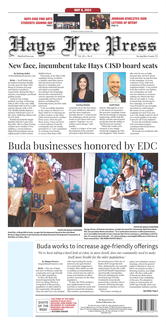This Week in Texas History
by BARTEE HAILE
Gov. John Ireland did a political about-face on Oct. 10, 1883, and called the state legislature back into special session to deal with the fence-cutting crisis that had turned western Texas into a war zone.
When barbed wire was introduced in the Lone Star State in 1875, the initial reaction from Texas cattlemen was decidedly cool. Skepticism usually greeted any Yankee import, and many feared the barbs would cut their cows to shreds. In fact, opposition was so strong at first that an attempt was made to ban the newfangled fence.
But the novelty rated a serious second look in West Texas. Stones and timber, the plentiful materials used elsewhere to keep livestock at home, were scarcer than hen’s teeth on the barren plains.
In 1876 a brash young peddler staged a promotional stunt that provided the perfect tonic for slumping sales. Erecting a razor-sharp corral on the Main Plaza in San Antonio, John “Bet-a-Million” Gates attracted the curious with an incredible claim.
“This fence is the finest in the world,” went the pitch. “Light as air, stronger than whiskey, cheaper than dirt, all steel and miles long. The cattle ain’t born that can get through it!”
To prove his point, the confident salesman let a herd of longhorns have a go at his product. After several fruitless charges at the impregnable barrier, the puzzled steers pulled back in pain. Following this dramatic demonstration, Gates had all the business he could handle.
The larger spreads bought the barbed fencing by the trainload. The Frying Pan Ranch shelled out $32,000 to enclose a 250,000-acre pasture in the Panhandle, and other beef barons followed suit.
The barbed wire craze touched off a frenzied land grab. Fences popped up on the open range with little regard for property rights or public convenience. Many small landowners lost everything, while roads, schools and churches were thoughtlessly cut off. In the counties of Archer and Jones, even the courthouses were ringed by impassable wire.
A violent backlash was inevitable. Besides farmers and small-fry stockmen, the barbed wire boom also galled cattle raisers who owned thousands of head but not a single acre of grazing land. Without the free grass and unrestricted access to water on the open range, the gypsy ranchers were finished.
A bone-dry drought in the summer of 1883 brought the matter to a head. When all that stood between his thirsty cattle and a water hole was a few strands of wire, a desperate nomad went to cutting.
With plenty of personal axes to grind, countless Texans joined the fence-cutting rampage. Although the vandalism was concentrated in a broad belt running from north to south through the heart of the state, barbed barriers were breached in more than half the counties in Texas.
So long as the victims were the mammoth ranches backed by out-of-state money, the public sided with the vigilantes. Popular sentiment was expressed by a poster that appeared in Coleman: “Down with monopolies! They can’t exist in Texas and especially in Coleman County! Away with your foreign capitalists. The range and soil of Texas belong to the heroes of the South.”
However, anyone with a pair of nippers could clip a fence, and soon indiscriminate rowdies were running amuck. No one’s fence was safe.
When the damage exceeded $20 million, including a million dollars in Brown County alone, the fence cutter ceased to be seen as the Robin Hood of the range. Newspapers across the state demanded that Gov. Ireland put a stop to “the hell hounds of Texas,” as the snippers were called.
The governor tried his best to dodge the controversy, but an irate press left no room for maneuver. In October 1883 Ireland summoned legislators to a January special session with a carefully worded invitation requesting “a remedy for the wanton destruction of fences.”
Annoyed at being awakened from their scheduled hibernation, the grumbling politicians trudged back to Austin. Weeks of heated debate created a package of new laws designed to restore law and order on the chaotic range.
Fence cutting was made a felony punishable by a prison term of one to five years. Conviction for malicious pasture burning, another favorite pastime, carried the same sentence. The fencing of public land or private property without the consent of the owner was also prohibited.
Energetic enforcement of the tough measures swiftly dispersed the loosely organized nippers, and in time most ranchers and farmers recognized the advantages of fencing their land. As for the itinerant cattlemen, the fence-cutting war was the last gasp of their dying breed.
Commemorate the Civil War Sesquicentennial with “Secession & Civil War” from the “Best of This Week in Texas History” collection. Order today at twith.com or mail a check for $14.20 to Bartee Haile, P.O. Box 152, Friendswood, TX 77549.




